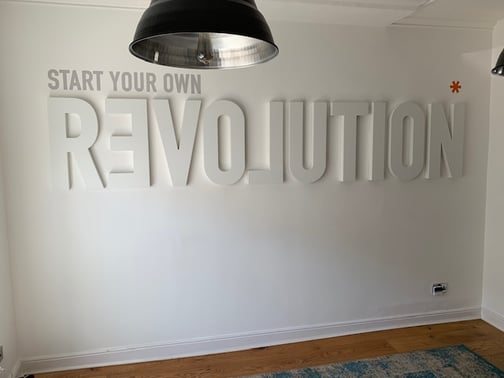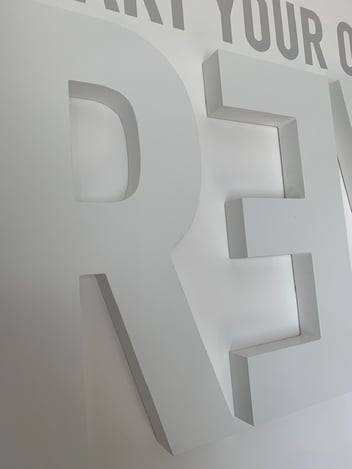
The amount of signage we are exposed to is constantly growing - but does that mean we take more or less notice of signs? Most likely the latter, which is why it’s so crucial to ensure your signage stands out from the crowd. To do that, would 2D or 3D be best?
Let’s take a look at a head-to-head comparison:
|
2D
|
3D
|
If you would like to see more on the comparison between 2D and 3D signage, take a look here.

As mentioned above, 3D signs or even 3D displays are much more likely to have an impact, mainly because you have more to work with and greater flexibility with design and what you can include. However, there are other benefits to choosing a 3D option for your signage or displays.
3D enables you to communicate your message without using text, making them easier to ‘read’ at a glance.
So, if you’re looking to create more impact and want to know more about the benefits of using 3D signage, take a look at this blog post.

As touched upon in the previous section, signs and displays can truly be brought to life using 3D design. However, alongside this you can also use things including 3D lettering, functional elements like clocks and information boards, or situational things surrounding your sign, like street lights or trees.
Functional elements like clocks make your sign useful and can draw people into viewing it more. Other examples of this might include using signs people typically look for to leverage your own advertising, like directional signs.
Otherwise, taking the opportunity to utilise things that surround your sign will draw people in further, prompting them to think about the composition of the sign meaning it will stay in their mind for longer. It may even become a feature that they point out to friends and family.
If you want to read more about this and how to get inspiration for bringing your sign to life, take a look here.
Sign block is a material made from polyurethane which possesses particularly desirable characteristics for 3D signage and bespoke displays. Also known as HDU Foam or Tooling Board, Sign Block is light-weight yet durable making it ideal for POS displays and exhibition graphics, as it can be put up and packed away multiple times without being damaged - or causing heavy-lifting or safety issues.
The material is relatively flexible when it comes to design and can be machined to create 3D designs or profiled down for more 2-dimensional signage. Typically, standard Sign Block comes in 2 shades: mint green and a peach colour which are used to communicate the density of the material. However, any number of finishes can be applied to the material meaning it can be made to look like almost anything!
Sign block is best known for being a sturdier replacement for Polystyrene, however it can be made to look like wood, metal or even brick work so provides great flexibility!
Take a look here for more information on Sign Block!
Sign Block is an ideal signage material for many things. However, as it is relatively new to the market with many print suppliers are not yet working with the material, and may be unaware of the vast number of benefits there are to working with the material.
So, why should you work with sign block? Let us tell you:
Take a look here for more information on the benefits of using Sign block!
Sign Block is a relatively new material to the signage market and has a number of benefits suitable for indoor, outdoor, 3D and 2D signs, and not to be overlooked. Many compare the material qualities of Sign Block to that of polystyrene due to it’s foam like consistency and its suitability to both 2D and 3D design.
So, why would you choose to use Sign Block over Polystyrene? This blog directly compares the two materials, but take a look below for a brief overview.
|
Polystyrene
|
Sign Block
|
Sign Block is also particularly useful when it comes to making film or theatre sets. Quite often. Props and sets are moved, man-handled and need to be able to last for long runs meaning polystyrene isn’t always suitable. Sign block however, is much better suited as it can sustain the knocks, bumps and scrapes that polystyrene simply can’t. Not only this, but its ability to be made to look like just about anything means it is even more ideal for film and theatre sets. Whether you need to simulate brick, metal or wooden props and surfaces, sign block is ideal.
For more details on the future of film sets and sign block, take a look here.
What is Sign Block?
Sign block is a plastic derivative made from polyurethane and commonly used for 3D signage and bespoke displays.
Lightweight yet durable, it lends itself to POS displays and exhibition graphics in particular.
Sign block is also known as HDU Foam or Tooling Board.
What is Sign Block made of?
Sign Block is made from polyurethane and is an example of a form of Heavy Duty Urethane Foam (HDU).
Unlike alternate foams it contains a consistent structure at its core, allowing for greater durability.
What are the benefits of Sign Block?
There are many benefits to using sign block.
The material is incredibly versatile and can be customised to produce a variety of looks and finishes.
The substance is light weight and can be used without heavy duty fittings. Sign block is also extremely durable and can withstand the harshest conditions.
What size can I print Sign Block?
You can print onto sign block as thin as 5mm and as thick to 1000mm in a single sheet. The substrate can also be easily shaped and carved.
How do you print Sign Block?
Evans Graphics digitally print onto sign block using large format flatbed printers.
This machinery boasts large format cutting, routing and finishing capabilities for those looking to create display boards or props on a movie set… for which sign block has also become synonymous.
How much does it cost to print onto Sign Block?
Printing onto sign block can cost anywhere between £900 and £3,000 depending on your exact requirements.
To request a quote, simply upload your artwork, along with a brief description on what you’re looking to create.
Should I use a 2D or 3D Sign Block?
Simple signage is best realised using 2D Sign Block. Examples include directional or instructional signs which are easier to read and cheaper to produce.
3D Sign Block lends itself to high impact signage such as those used for exhibition stands or reception areas.
3D signs provide greater value for money and can last longer than traditional signs.
For an in-depth comparison of 2D and 3D signage, read our blog.
Why should I choose Sign Block over Polystyrene?
Much like Polystyrene, Sign Block is lightweight which makes it ideal for temporary POS and signage. Sign Block is far more durable given it’s a weatherproof material that can be used outside without fear of rotting.
While both Sign Block and Polystyrene can be coloured or patterned in different ways, Sign Block has a much cleaner finish and can be made to look like almost any other material.
If you have been tasked with creating a sign, be it for yourself, a client or the business you work for, our free signage advice pack will help you consider:
At Evans Graphics, we pride ourselves on giving advice where we can and taking your idea, no matter how obscure it might be, and making it a reality!
Units 2 & 4,
Little John's Lane,
(Albury Close, off Loverock Road)
Reading,
Berkshire,
RG30 1RA
Copyright © 2025 Evans Graphics Limited | Company number: 01912806
Powered by Intergage